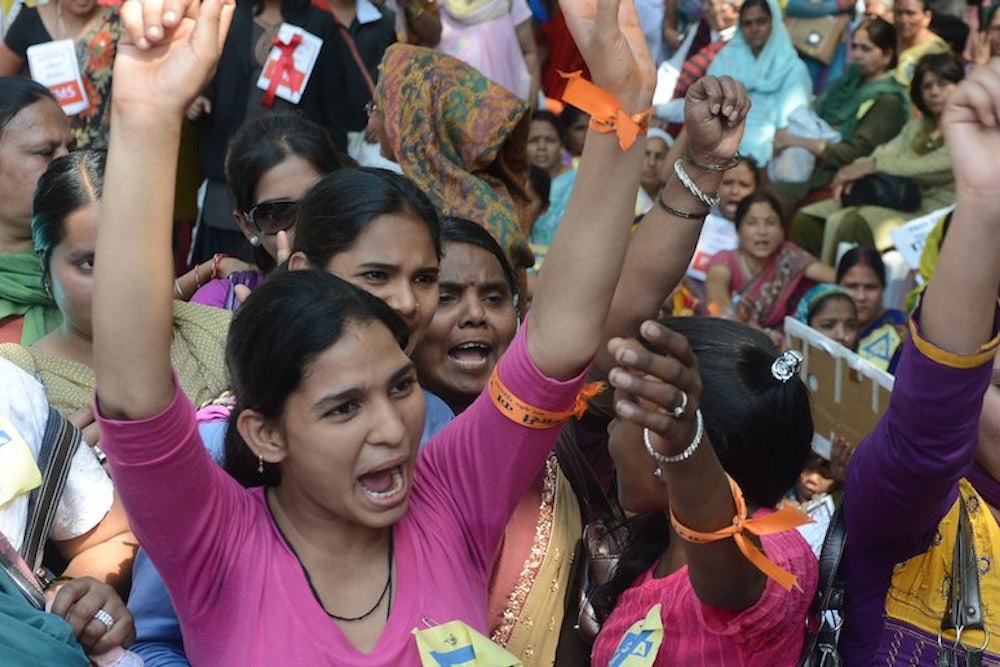Imagine a world where the proportion of girls being born is so low that large proportions of males just cannot find partners when they come of age. In such a world they are more likely to congregate in gangs for company. In turn, that means they are more likely to engage in risky behaviour: i.e. commit crime, do drugs and engage in violence against women. In gangs, men are more likely to harass women and even commit rape.
But this isn’t some dystopian fantasy – there are 37 million more men than women in India, and most of them are of marriageable age given the relatively young population. A social time-bomb is now setting off there with terrifying consequences.
While researching for my e-book on violence against women in India, earlier this year I came across an extraordinary article on why some brothers living in the same household were sharing a wife rather than marrying separate women.
Let that sink in for a moment. The Times of India reported in 2005 on instances where between two and five brothers living in a house, in rural areas in the state of Punjab, had married the same woman. It was extraordinary not just for what was in it, but for what was left out.
The article - "Draupadis bloom in rural Punjab" - cited two reasons for these polyandric arrangements: they prevented the household from splitting into multiple families and therefore dividing the meagre land they owned; men just could not find wives to settle down with. [The women are called "Draupadis" in reference to the princess who married five brothers in the Hindu epic The Mahabharata]. Punjabi writer Gurdial Singh told the Times of India: “the small landholdings and skewed sex ratio have abetted the problem."
A year ago, after the atrocious and widely-publicised gang-rape and murder of the student in Delhi, there has been much discussion of what is going on in India. Of course, the epidemic of violence against women is not an Indian problem alone.
But something more is going on there that deserves special attention. Not enough people inside India and outside realise the problem there is on a different scale because of the scale of sex-selection, which has meant that millions of girls who should be in the population are systematically wiped out.
We can put a number on this. To have a natural sex ratio like most of the world, India would need more women than men in its population. Around 23 million more women in fact. So, adding the 37 million (to equalise the number of men and women) to 23 million gives us an approximate figure of 60 million women "missing" from the population of India.
Punjab is ground-zero for this phenomena. Dividing up small land-holdings are not a new issue for the agricultural state; it’s the skewed sex-ratio which is the real problem. In a report published in 2009, the charity Action Aid India found that among some communities in Punjab there were as less as 300 girls per 1,000 boys. Overall, it is among the worst states in the country for the female to male ratio.
There’s a huge deficit of women because families fear the cost of raising a daughter. It is a commonly practiced tradition (despite being outlawed) that the bride’s family pays a large sum of money to the groom’s family at the wedding. Plus, women are generally not seen as bread-winners and or allowed to inherit wealth like men in some states.
In the 1980s, an infamous ad run by private hospitals stated: "Pay 5,000 rupees today [to have an abortion] and save 50,000 rupees [in dowry payments] tomorrow." It was soon banned but the sentiments linger on. Sex-selection is now spreading to rural areas as the technology gets cheaper and enforcement of the law remains ineffectual. Media exposes of doctors providing sex-selection services and offering to abort girls are commonplace, but they have little overall impact because demand is too strong.
But sex-selection doesn’t paint the full picture. Large proportions of women are missing also because many poor families simply murder girl infants at birth if they can’t afford ultrasound and abortion services. Others simply neglect girls as they’re growing up (India is far and away the world's worst for differences in gender for child mortality). In fact, the sex-ratio of girls to boys under the age of 6 keeps dropping.
What’s extraordinary about all this is that until the gang-rape last year, the media paid very little attention to such issues. The Times of India report I mentioned for example neglected to interview any women and ask if they were happy with their arrangement. Neither does the reporter look into how widespread these arrangements were and what impact they were having on communities. It’s as if they were reporting on the price of onions, with a positive gloss of such marriages are ‘blooming’.
In reality, there are increasing stories of women being kidnapped or trafficked to be forced into marriages because men cannot find brides. Yet, until recently, there was an extraordinary unwillingness in the media to join the dots. The gang-rape last year started a debate about violence against women in India, but for many women the impact of this social time-bomb are being felt now.
This piece first appeared on newstatesman.com.
